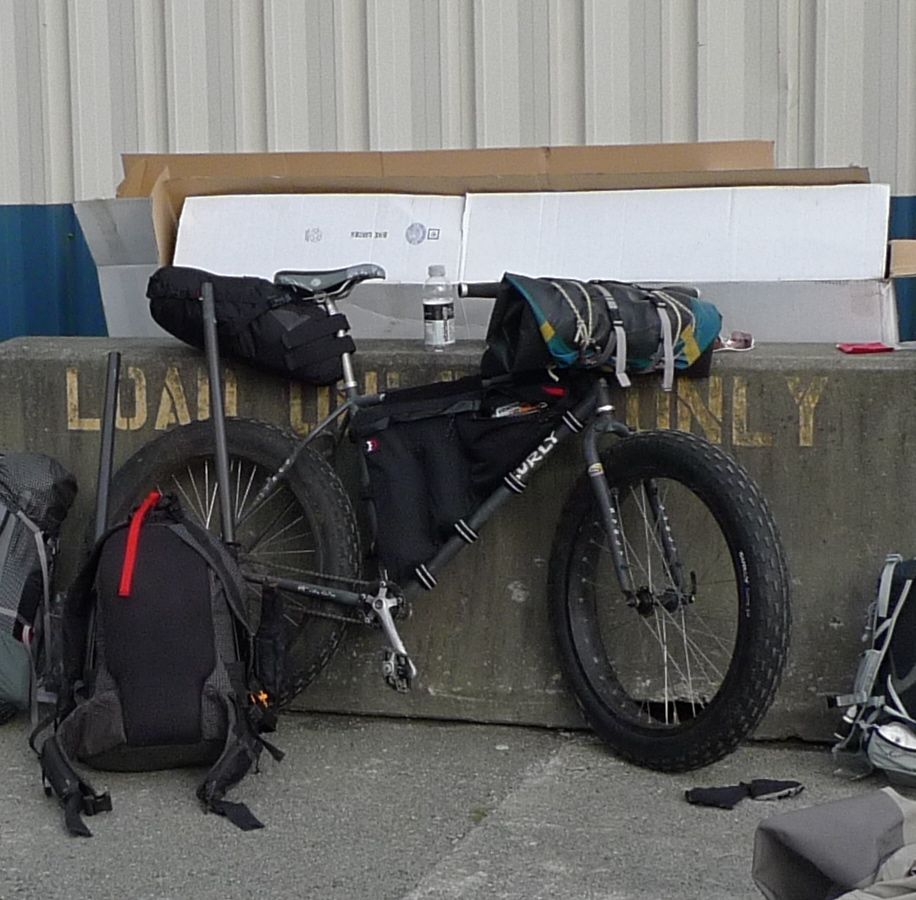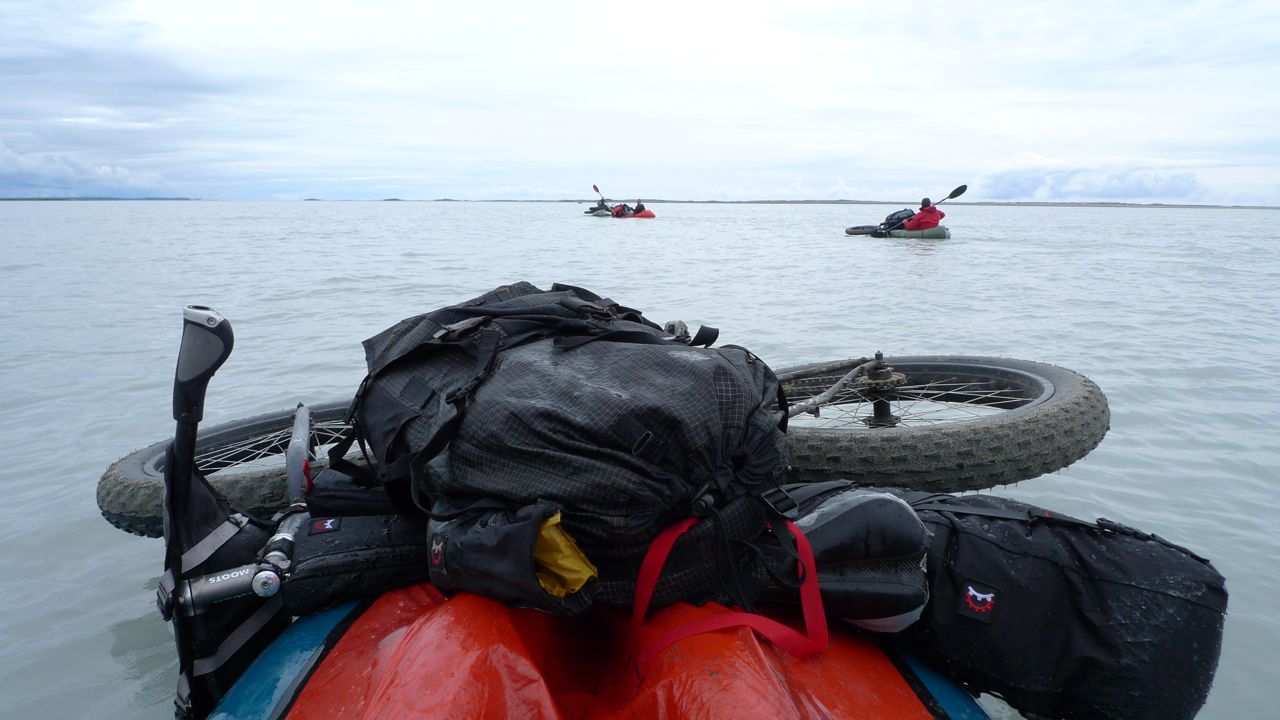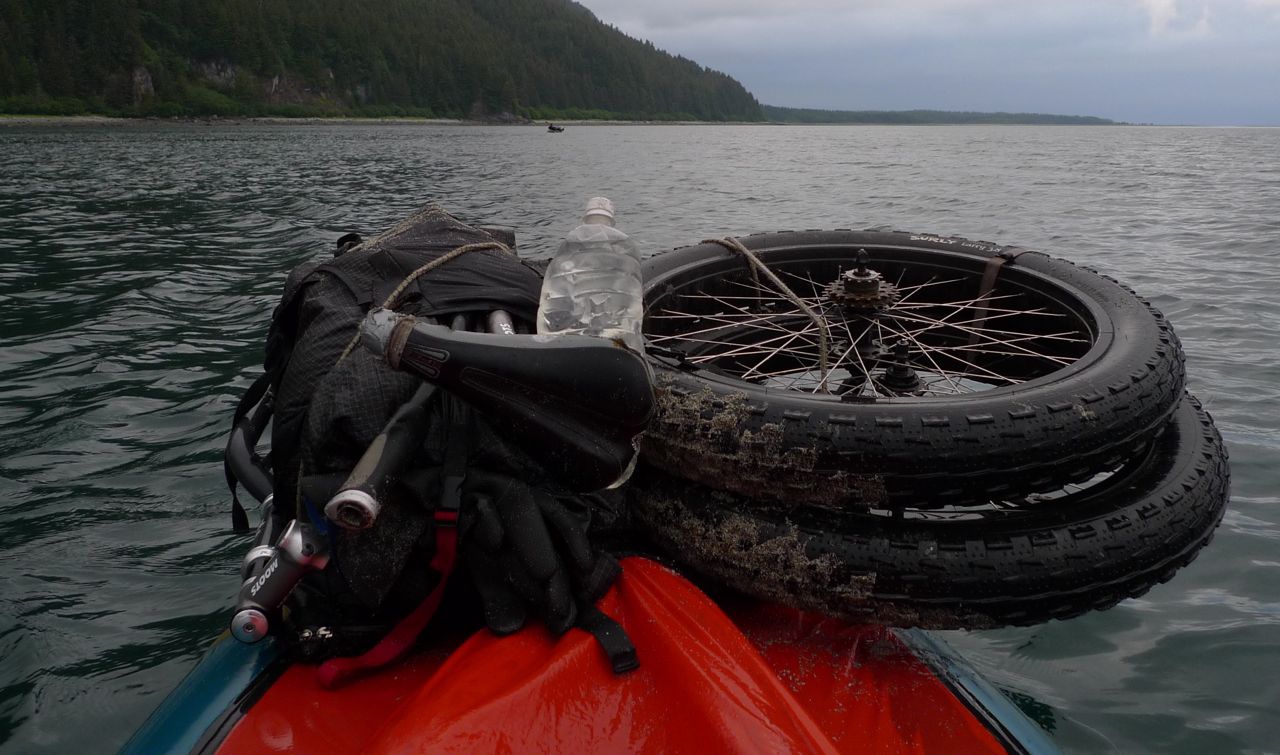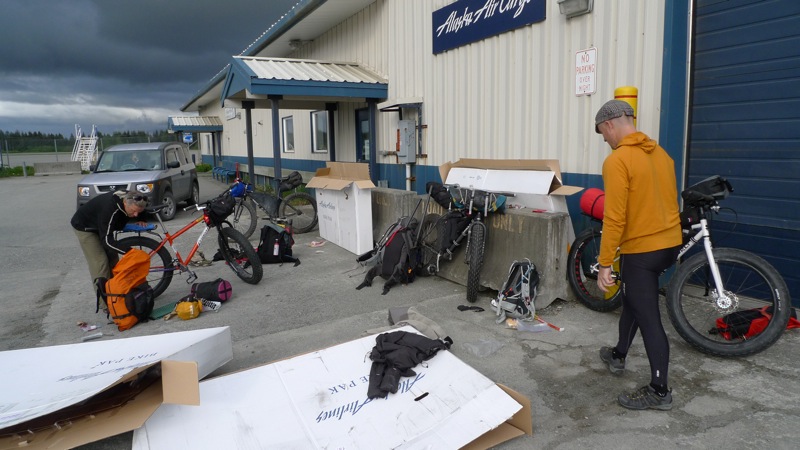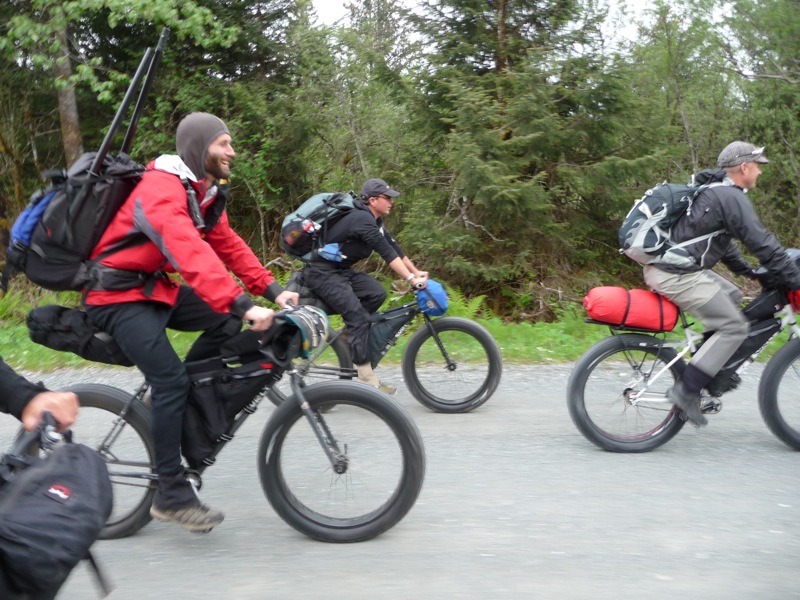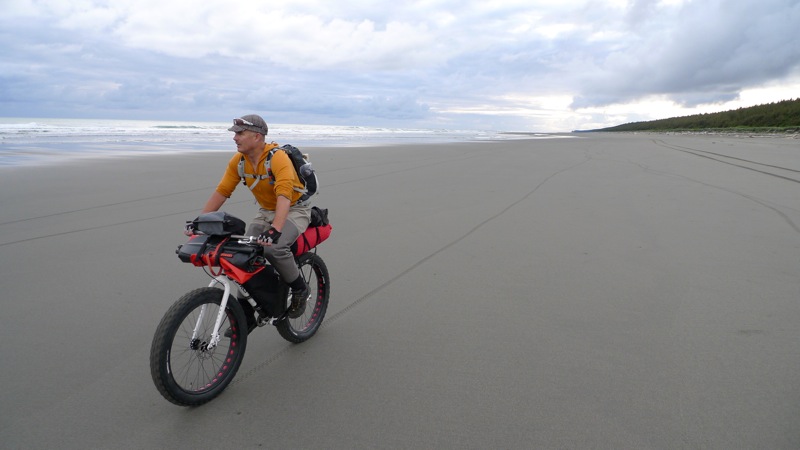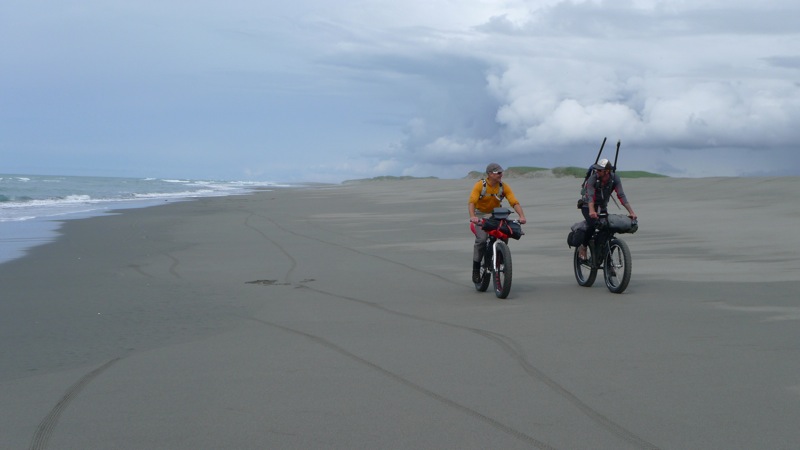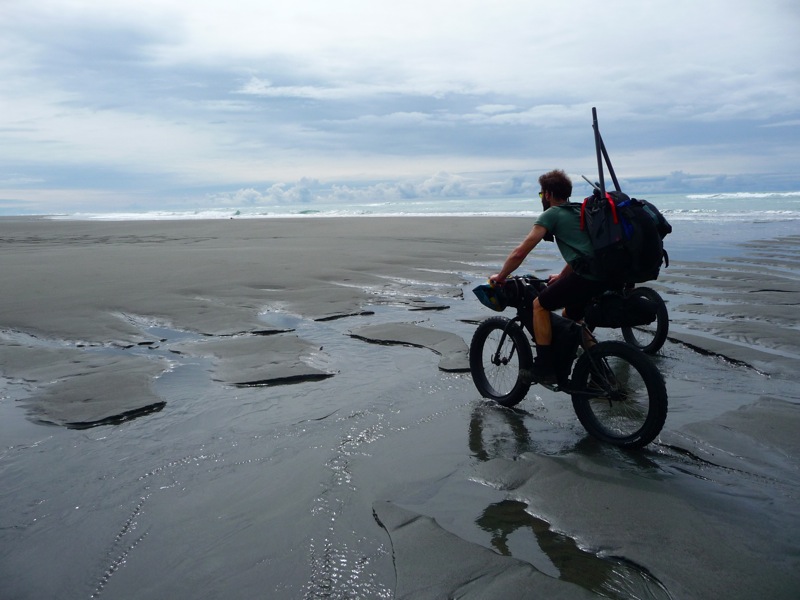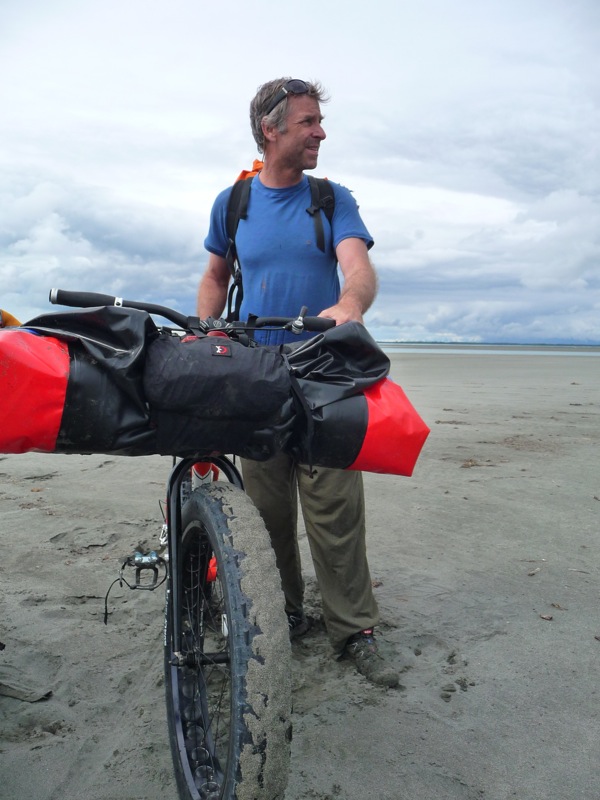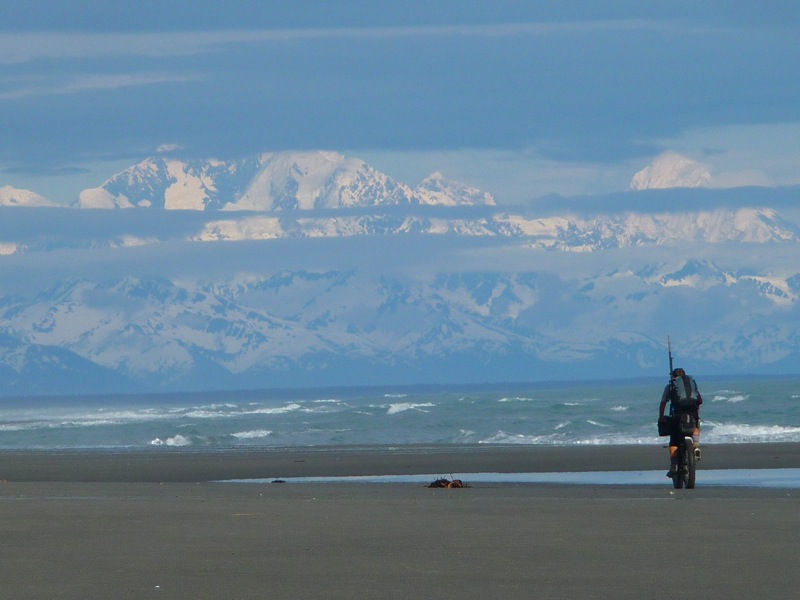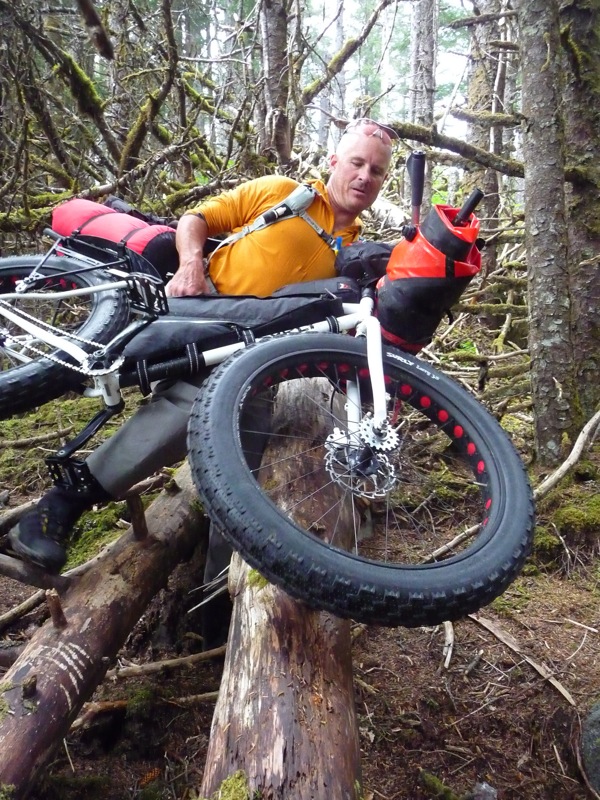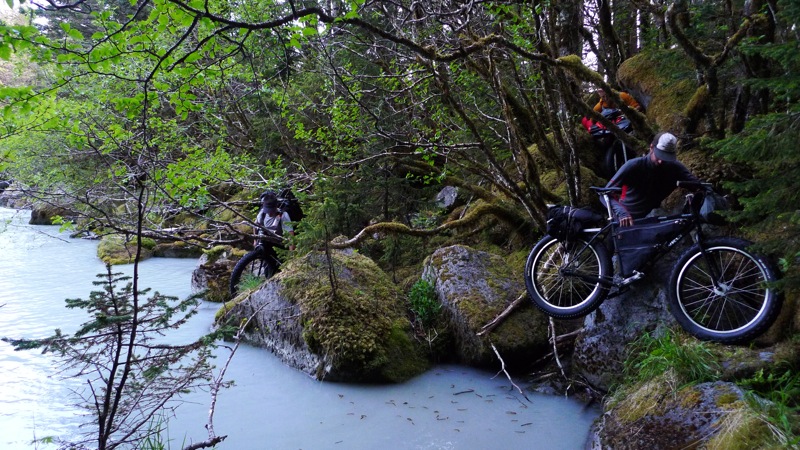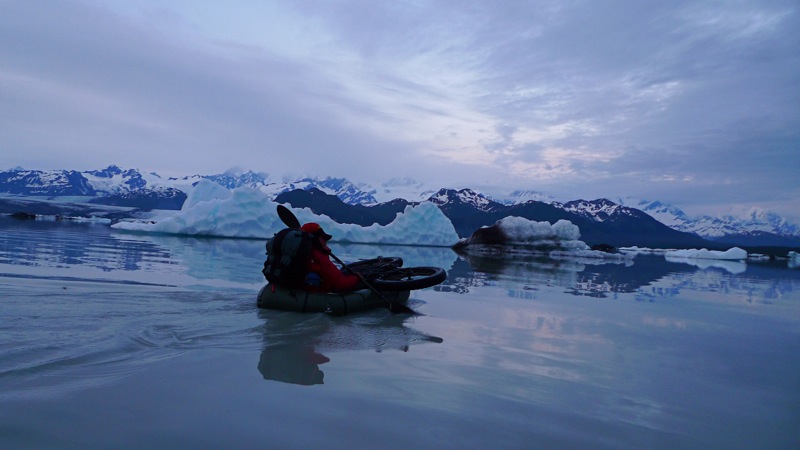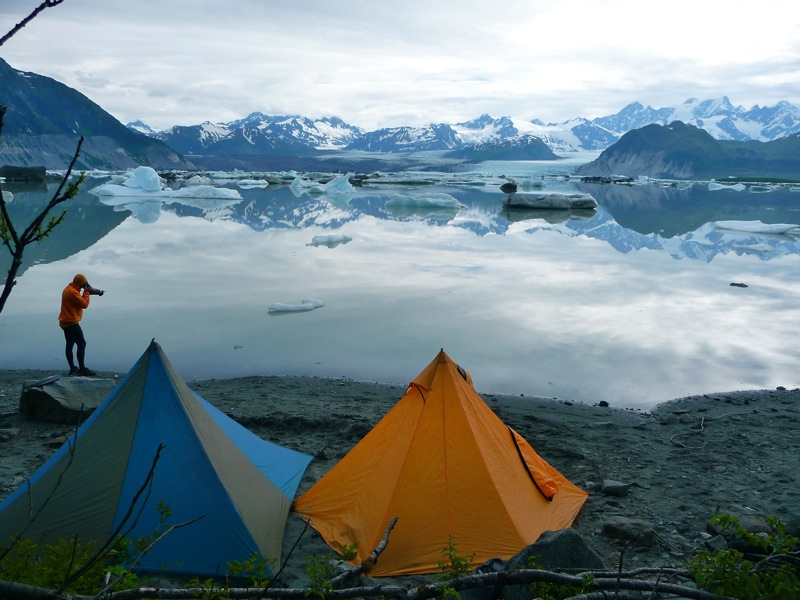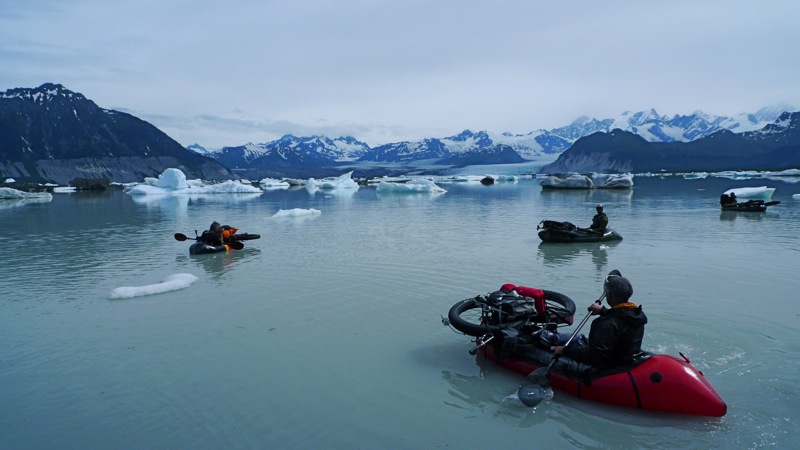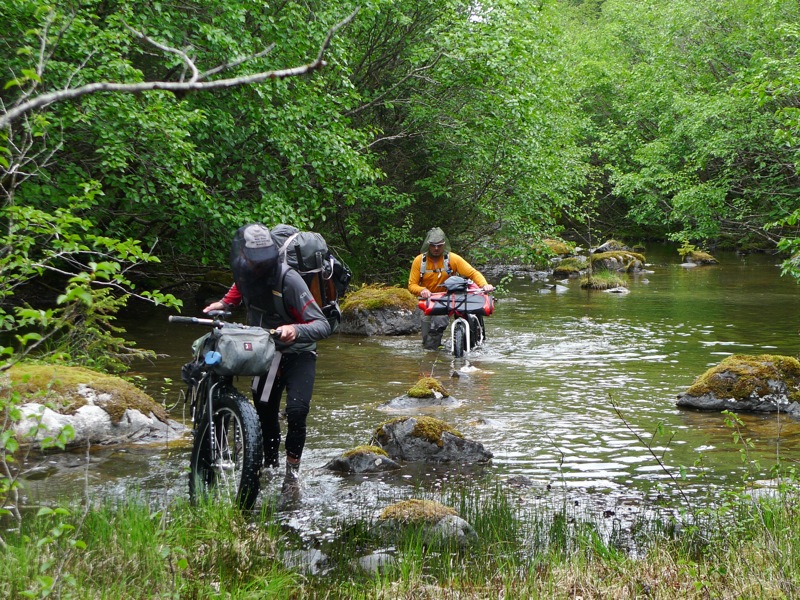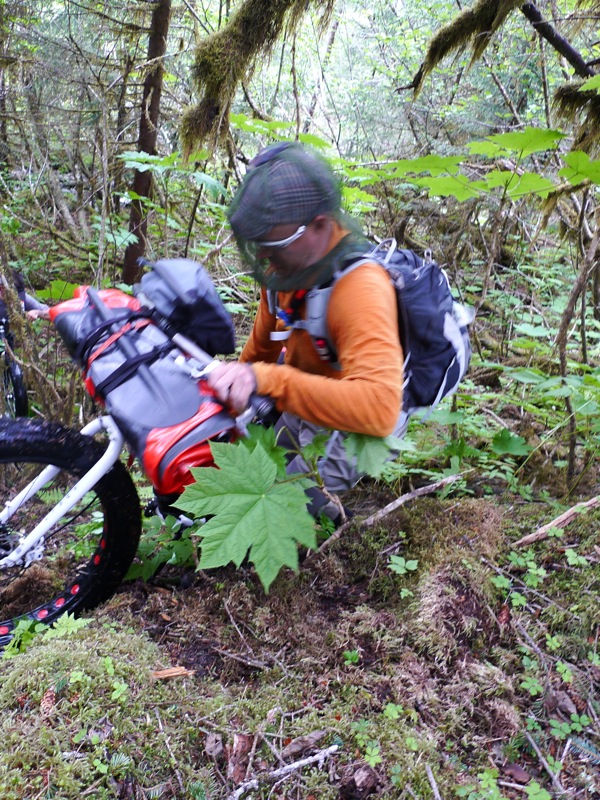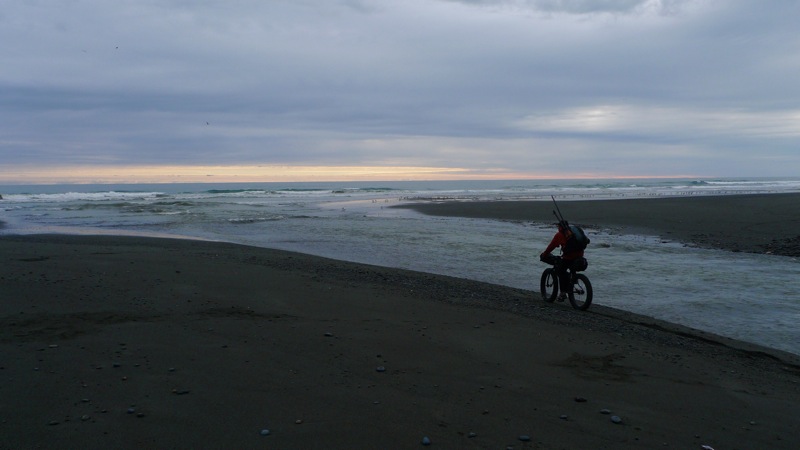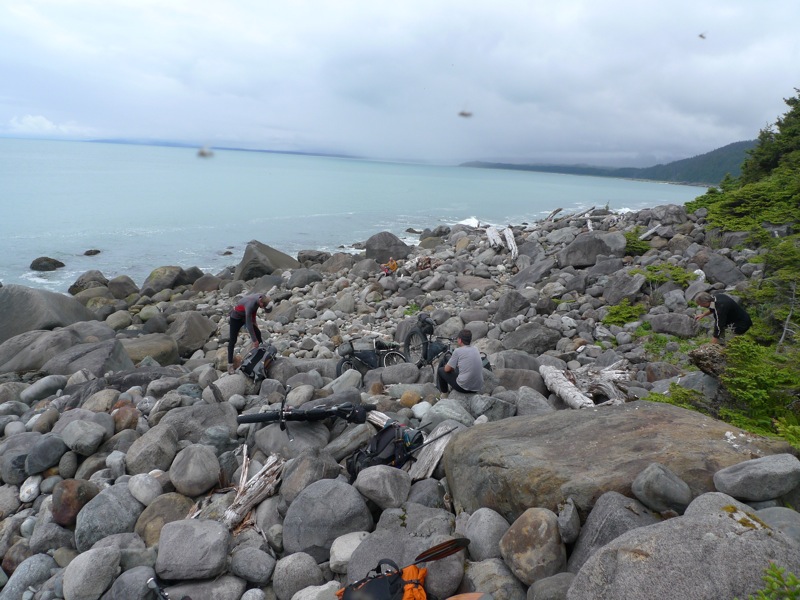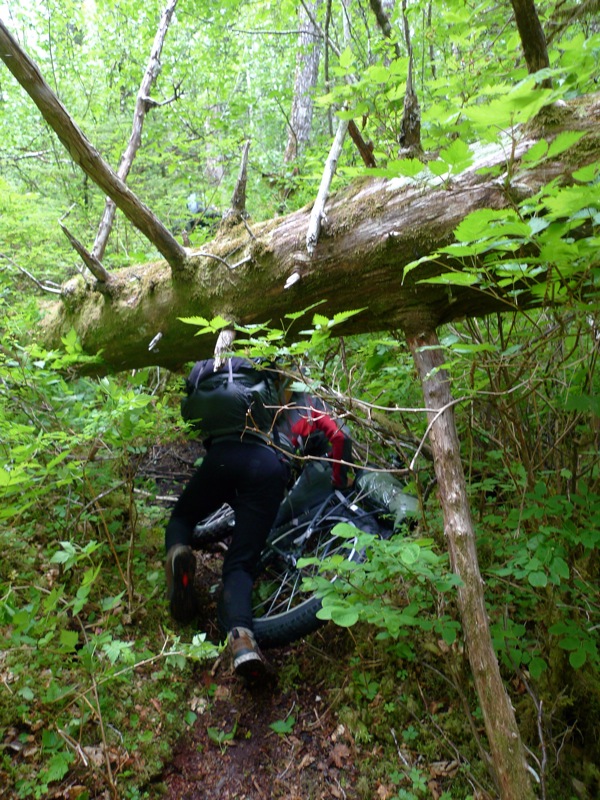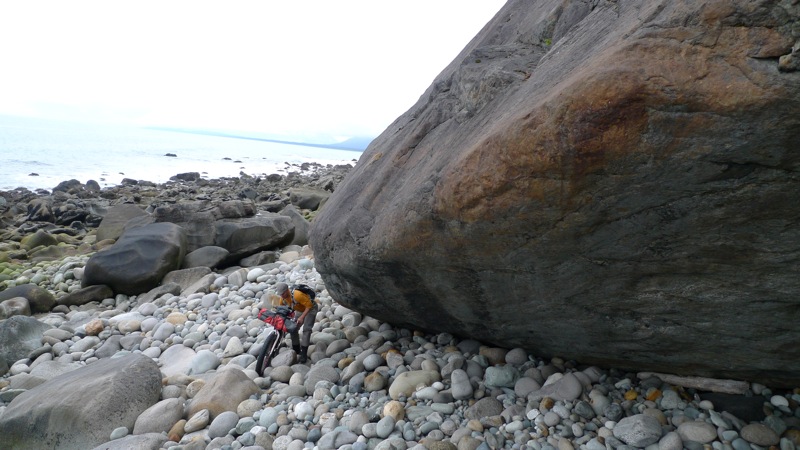I've had a bunch of questions about gear for the beach trip so here goes. A key point in this however is not so much what, is how. What's loaded where is constantly in flux.
BIKE:
Old style pugsley, 80 mm chopper rims, larry's, thick surly tubes, singlespeed 22-20/22 with bashring, XT freewheel, surly front hub, no brakes, salsa 17 degree straight bars, square taper cranks, phil bb.
The trend with fat bike design is for more and more standover but I think it's over rated, it's not an issue for me and I'd rather have the frame bag space for big trips. If all I rode was winter singletrack then I'd have a different opinion.
Brakes are only useful when pushing and you want to keep the bike from slipping back, but they die no matter what within a few days, even if they don't die the sound of grinding grit will make you sick of them.
seat bag:
I used a stock Viscacha on this last trip and liked it better than the rack & drybag combo used on Yak-Cordova. Inside the bag I had 12 days of dinners and breakfasts in a fitted drybag, Iridium Satellite phone in hard case, the megamid and once some dinners were eaten, a spare surly tube. Totally full! I think this is the max length of trip for this setup. One trick I learned was that for stream crossings I could loosen the post and swing the seat 180 degrees keeping all the load, frame bag and seat bag (all the dense food weight) centered on the boat. Another advantage is less paddling interference than a rack for long paddles when the bike is stripped down, less to catch on bushwacking, and it's lighter. Man i sound like I'm sponsored by them of something.
Frame bag:
The bag I used was a big, simple, single zip, tapered front bag with 2 vertical dividers. I made heat sealed dry bags for the 2 vertical compartments which held my daytime snacks for 12 days. The front section held 2 x 20oz water bottles and pedals when they were off the bike. The skinny drybags worked very well since they were super easy to unload into my pack for schwacking and pushing. I took the bag completely off once and shoved it into my pack's beavertail when we played roulette with the La Parouse glacier and I wanted to be able to run with the totally stripped bike on my shoulder... and that I did!
Gas tank:
multi tool, chain lube, bug net, random crap. The new design kept more water out for sure.
Front:
Packraft and sometimes paddles loaded in a Sling. Worked good, last minute decision, I would have brought one of the small pockets next time to go with it. What was nice is that the straps could be used for other things.
Pack: old home made, 22 oz, 45-50ish L (?) with beavertail, no lid, frameless. Key to be able to unload bike to varying degrees and be able to carry everything. When biking it was pretty light with zero water or food weight, carrying only sleep stuff (go lite syn. quilt, prolite XS pad, sleep socks), clothing, ti cookpot, and random stuff drybag (camera batteries, repair kit, ibu) and PFD. I empty it every night and use it as the sleeping pad for my legs.
PDF - Opinions differ but I like using a real PDF, simple kokatat. Sure it's heavier and bulkier than alternatives but... Its safe in the water, part of my sleeping pad setup and can be used as an insulation layer under rain jacket giving a warm buffer between your body and wet pack, that's the clincher personally. On Yakutat north we wore them probably 40% of the time, all day for added warmth. We had superb weather so did not use it really at all for that on this trip.
Clothing:
Thin wool T, Ibex hooded indie, home made wind pro hooded fleece (similar to an R1 hoodie) older REI gossamer hooded puff, go lite storm rain jacket with modified wrist cuffs. Bottom: Patagonia R.5 tights, homemade fleece tights, homemade goretex rain pants with neoprene ankle cuffs and a extension that came up mid-torso. Patagonia release runners with sewn on mini gators (nice and durable uppers but the soles could be better... you are so close Patagonia!) wool socks, NRS hydroskin thin neoprene socks, simple kenai neoprene gloves (luxury).
Since the weather was so darn dry and warm on this trip I did not get to compare how the Ibex wool layer compared to just using fleece against skin. When it's really wet I like just a T, then fleece. Nothing long sleeve synthetic or wicking since it just stays wet and cold, wicking from wrist up.
Shelter:
MC and I shared a BD megalight mid, the other was a go-lite mid, using the paddle shaft as pole. Splat paddles works fine but the adjustable length of the Sawyer paddles sure is nice. no stakes, I use small parachutes made of ripstop and ribbon at the 4 corners for sand and rocks.
Raft:
Old stlye llama circa 2003, with old deck. 2 thick bungee's tied off on the front, mini biners on the other ends. works for me, tons of ways to go about it. The pro-lite XS fits like a glove behind and under the seat for back comfort and warmth.
Bike to Packraft changes:
The prep (or lack of) taken for paddling goes in varying degrees. Basically for quick river crossings and the water is mellow I just put the bike across the front and jump in the boat, Pack either still on my back, or on top of the bike. This way I can quickly jump out of the boat and get everything out of the water since the bike is not attached, It's fast and efficient and great for when there is quicksand, no eddys etc. This disaster style method (thank you Kelly Cordes) gets dodgy as Dylan and I once learned when there is any sort of wind / wave action which might move the bike on the deck, but for most stream crossings it's totally fine.
For long paddles, it's pedals off, seat post off, handle bar off and everything packed tight and compact. Doing this I can get full paddle stroke and go for hours.
Bike to schwack:
Minimally it's pedals off and handlebars unloaded. That's fine for most pushing. If Carrying is involved then food gets unloaded into the backpack using the drybags. For mega-schwacks the seapost gets dropped and the seat bag comes off.
What else? Lumix LX3 camera in a mini shoulder strap drybag case. Bear spray on pack strap bungee. Cookset was 4 oz of 99% alchool and a Ti pot. The alcohol used as fire starter and aquaseal repair prep. With the dry weather we cooked exclusively on fires had a minimum of 2 a day with abundant hot meals. If it had been raining lots, then fire starting would have been more interesting and I would have eaten more cheese and cookie dough for breakfast.
All this stuff has been learned through trial and error. After this trip the only change I'd make would have been bringing the dark lenses not yellow for my sunglasses and maybe a visor. That's it.
all my secrets. go nuts.
Wednesday, July 06, 2011
Tuesday, July 05, 2011
Mike's Video
Don't even think of watching this without pressing the full screen button!
Bikerafting Alaska's Lost Coast: Yakutat to Glacier Bay. from lacemine29 on Vimeo.
Friday, July 01, 2011
Yakutat to Gustavus Coast Trip part 1
11 days in the wilderness.. how do you sum it up and put it into words? I always have a problem with it and every effort falls short. This will be no exception since my brain is mush and has been in a stream of conscious mode since I've been back.
We had nothing short of a fantastic trip. The weather cooperated, the route was excellent with good riding and a host of challenges, our group was solid and could crack dirty jokes 27 hrs a day. But leaving it at that would not make for much of a story. Details! photos! right?! ok fine. twist my arm.
I've been thinking about this and the best way I can describe how this trip came about is "Circular Inspiration". Roman did bad ass trips in the 90's that blew the doors off the notion of wilderness mountain biking as we know it. Following in the footsteps, Dylan and I were amped on the concept and started packrafting with our bikes a few years ago. Eventually We spent 19 days riding, pushing and paddling our Pugsleys on the northern section of the Lost Coast from Yakutat to Cordova, a route brought to light by Erin and Hig who walked it. At some point a now older and wiser Roman saw the new bikes and the potential... bought one this spring and proposed doing the Southern part - Yakutat south. um yes, Game on! Friends from Colorado, Steve Fassbinder and Mike Curiak, both well versed in the world beyond 2.25" joined in. It was quite the crew, well rounded (literally for some) and experienced.
Expedition Coastal fat tire biking is a unique animal. It's gear intensive with Bikes and packrafts, yet simple and primal. When things click it makes for a very efficient method of travel without the mundane of simply walking. Yet there's more too it than that. You'll have try it for your self, but for me it has something to do with real adventure riding. The giddy feeling of riding where nobody has biked (or even thought of it!) in a remote environment with the self reliance and determination that comes with it. There I tried.
(The photos in this post are a mix of mine and some of DOom's)
Off to Yakutat, landing there and prepping our bikes brought on total deja-vu of 3 years earlier. Same bikes, same flight, same bacon cheeseburger from the lodge.
Heading out to the beach:
We had the perfect night, a low tide that made for a fat tire playground. Gigapixels were burned finally on the beach.
Roman with fatties..
a funny thing happens when everyone is spinning nearly the same gear combo...
We enjoyed near perfect beach for the first 2 days. Crossed Situk Lagoon, The Dangerous River and finally the Alsek as we worked our way closer to the Fairweather range.
We spent the whole trip traversing below all these peaks.
Immense mountains smack in front of us, crashing surf off to the right. Is this really happening or am I dreaming? if so don't pinch me..
At the end of the third day we hit Boulders. Boulders on the beach mean big glaciers are close by. Following bear trails we went up into the woods and schwacked to the lagoon formed by the Grand Plateau Glacier. (note clawage)
We reached the lagoon as the evening's chill was upon us, combined with icebergs and glacier melt made for a brisk paddle in search of a camp spot.
We found one, a tiny stretch of beach between the alders and rocks.
Tall tales by the campfire accompanied sporadic glacier calving off in the distance and we hoped that the lake level would not rise from the mini tsunamis and swamp our camp.
Putting in the next day, everyone giddy for good reason!
Our exit from the lake was a bit of a crap shoot. Our maps (last updated decades ago) showed a braided stream leaving on the far end of the lake. Our plan was to follow that back down to the beach. We did, but the stream was not really there anymore. The landscape had changed dramatically and we climbed up away from the lake in full on schwackfest swamp mode.
We found the stream, but it was just slime covered boulders, balls deep at times.
Off the stream and into the quality. Mike gets acquainted with Devils Club and all that summer Alaska trip have to offer.
A few hours later we broke out onto the coast. The massive boulders were gone and we were greeted to smooth and ridable beach. This would be the theme for days to come. Bash and bushwack in the morning, cruise in the evening.
Cape Fairweather - Subdivision sized boulders loomed ahead. I figured a solid 4 hrs to get around it all. It took us about 6 or so reminiscent of the Sitaki Bluffs along the Malispina Glacier. It was here that Roman educated us on the aptly suitable verb "Stumblefucking" nothing describes it better. Roman obviously derived the term from decades of perfecting the art. You bash along with your bike in mind numbing tedium. Thought process slows, as does time. Your body tires from the minute yet strenuous movements needed to carry, push and bash though the cobbles and boulders. The only thought that need to be held on to is that yes, the bike will be useful again at some point so keep bashing, you're having fun you idoit.
Bear trails, not the best maintained in these parts. good times!
they grow em big out here.
As evening progressed we left the boulders behind and were quickly greeted to the goods. re-pack, pedals on. I was in no hurry this night however. After a solid day of stumblefucking the big trees, big beach and big ocean brought a sense of calm. an erie calm in a way, something that made me think that this moment right here and then, is what I came for.
We had nothing short of a fantastic trip. The weather cooperated, the route was excellent with good riding and a host of challenges, our group was solid and could crack dirty jokes 27 hrs a day. But leaving it at that would not make for much of a story. Details! photos! right?! ok fine. twist my arm.
I've been thinking about this and the best way I can describe how this trip came about is "Circular Inspiration". Roman did bad ass trips in the 90's that blew the doors off the notion of wilderness mountain biking as we know it. Following in the footsteps, Dylan and I were amped on the concept and started packrafting with our bikes a few years ago. Eventually We spent 19 days riding, pushing and paddling our Pugsleys on the northern section of the Lost Coast from Yakutat to Cordova, a route brought to light by Erin and Hig who walked it. At some point a now older and wiser Roman saw the new bikes and the potential... bought one this spring and proposed doing the Southern part - Yakutat south. um yes, Game on! Friends from Colorado, Steve Fassbinder and Mike Curiak, both well versed in the world beyond 2.25" joined in. It was quite the crew, well rounded (literally for some) and experienced.
Expedition Coastal fat tire biking is a unique animal. It's gear intensive with Bikes and packrafts, yet simple and primal. When things click it makes for a very efficient method of travel without the mundane of simply walking. Yet there's more too it than that. You'll have try it for your self, but for me it has something to do with real adventure riding. The giddy feeling of riding where nobody has biked (or even thought of it!) in a remote environment with the self reliance and determination that comes with it. There I tried.
(The photos in this post are a mix of mine and some of DOom's)
Off to Yakutat, landing there and prepping our bikes brought on total deja-vu of 3 years earlier. Same bikes, same flight, same bacon cheeseburger from the lodge.
Heading out to the beach:
We had the perfect night, a low tide that made for a fat tire playground. Gigapixels were burned finally on the beach.
Roman with fatties..
a funny thing happens when everyone is spinning nearly the same gear combo...
We enjoyed near perfect beach for the first 2 days. Crossed Situk Lagoon, The Dangerous River and finally the Alsek as we worked our way closer to the Fairweather range.
We spent the whole trip traversing below all these peaks.
Immense mountains smack in front of us, crashing surf off to the right. Is this really happening or am I dreaming? if so don't pinch me..
At the end of the third day we hit Boulders. Boulders on the beach mean big glaciers are close by. Following bear trails we went up into the woods and schwacked to the lagoon formed by the Grand Plateau Glacier. (note clawage)
We reached the lagoon as the evening's chill was upon us, combined with icebergs and glacier melt made for a brisk paddle in search of a camp spot.
We found one, a tiny stretch of beach between the alders and rocks.
Tall tales by the campfire accompanied sporadic glacier calving off in the distance and we hoped that the lake level would not rise from the mini tsunamis and swamp our camp.
Putting in the next day, everyone giddy for good reason!
Our exit from the lake was a bit of a crap shoot. Our maps (last updated decades ago) showed a braided stream leaving on the far end of the lake. Our plan was to follow that back down to the beach. We did, but the stream was not really there anymore. The landscape had changed dramatically and we climbed up away from the lake in full on schwackfest swamp mode.
We found the stream, but it was just slime covered boulders, balls deep at times.
Off the stream and into the quality. Mike gets acquainted with Devils Club and all that summer Alaska trip have to offer.
A few hours later we broke out onto the coast. The massive boulders were gone and we were greeted to smooth and ridable beach. This would be the theme for days to come. Bash and bushwack in the morning, cruise in the evening.
Cape Fairweather - Subdivision sized boulders loomed ahead. I figured a solid 4 hrs to get around it all. It took us about 6 or so reminiscent of the Sitaki Bluffs along the Malispina Glacier. It was here that Roman educated us on the aptly suitable verb "Stumblefucking" nothing describes it better. Roman obviously derived the term from decades of perfecting the art. You bash along with your bike in mind numbing tedium. Thought process slows, as does time. Your body tires from the minute yet strenuous movements needed to carry, push and bash though the cobbles and boulders. The only thought that need to be held on to is that yes, the bike will be useful again at some point so keep bashing, you're having fun you idoit.
Bear trails, not the best maintained in these parts. good times!
they grow em big out here.
As evening progressed we left the boulders behind and were quickly greeted to the goods. re-pack, pedals on. I was in no hurry this night however. After a solid day of stumblefucking the big trees, big beach and big ocean brought a sense of calm. an erie calm in a way, something that made me think that this moment right here and then, is what I came for.
Subscribe to:
Posts (Atom)
